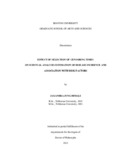Please use this identifier to cite or link to this item:
http://archive.nnl.gov.np:8080/handle/123456789/457| Title: | Effect of selection of censoring times on survival analysis estimation of disease incidence and association with risk factors |
| Authors: | Himali, Jayandra Jung |
| Keywords: | Framingham heart study Censoring Survival model |
| Issue Date: | 28-Feb-2018 |
| Abstract: | In longitudinal cohort studies, potential risk factors are measured at baseline, subjects are followed over time, and disease endpoints are ascertained via extensive surveillance. Individual follow-up time is from baseline to the event, if one is observed during the study period. Follow-up time is censored for subjects who are not observed to have the event during the study period, at the end of the study period for subjects who remain event-free, but during the study period for subjects who leave the study early by choice or by mortality, or whose last evaluation was before the end of the study. Survival analytic techniques are unique in that the unit of analysis is not the individual but the person-time contributed by the individual. Surveillance in longitudinal studies is generally quite rigorous. Subjects are examined in waves and their event status is ascertained. Surveillance continues between waves, and events come to the attention of the investigator. If there is a long time between waves, analyses can be conducted on all available data, with non-events censored early at the last examination and events followed beyond the general examination to the incident event. Motivated by analyses using the Framingham Heart Study (FHS) with cardiovascular endpoints, we consider four censoring methods for non-events and evaluate their impact on estimates of incidence, and on tests of association between risk factors and incidence. We further investigate the impact of early censoring of non-events (as compared to events) under various scenarios with respect to incidence estimation, robustness, and power using a simulation study of Weibull survival models over a range of sample sizes and distribution parameters. Our FHS and simulation investigations show early censoring of non-events causes over estimation of incidence, particularly when the baseline incidence is low. Early censoring of non-events did not affect the robustness of the Wald test [Ho: Hazard Ratio (HR) =1]. However, in both the FHS and over the range of simulation scenarios, under early censoring of non-events, estimates of HR were closer to the null (1.0), and the power to detect associations with risk factors was markedly reduced. |
| Description: | Submitted in partial fulfillment of the requirements for the degree of Doctor of Philosophy, Boston University, Graduate School of Arts and Sciences, 2013. |
| URI: | http://103.69.125.248:8080/xmlui/handle/123456789/457 |
| Appears in Collections: | 600 Technology (Applied sciences) |
Files in This Item:
| File | Description | Size | Format | |
|---|---|---|---|---|
| Dissertation_JayandraJungHimali_04102013.pdf | 4.28 MB | Adobe PDF |  View/Open |
Items in DSpace are protected by copyright, with all rights reserved, unless otherwise indicated.